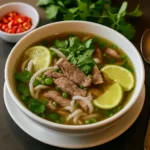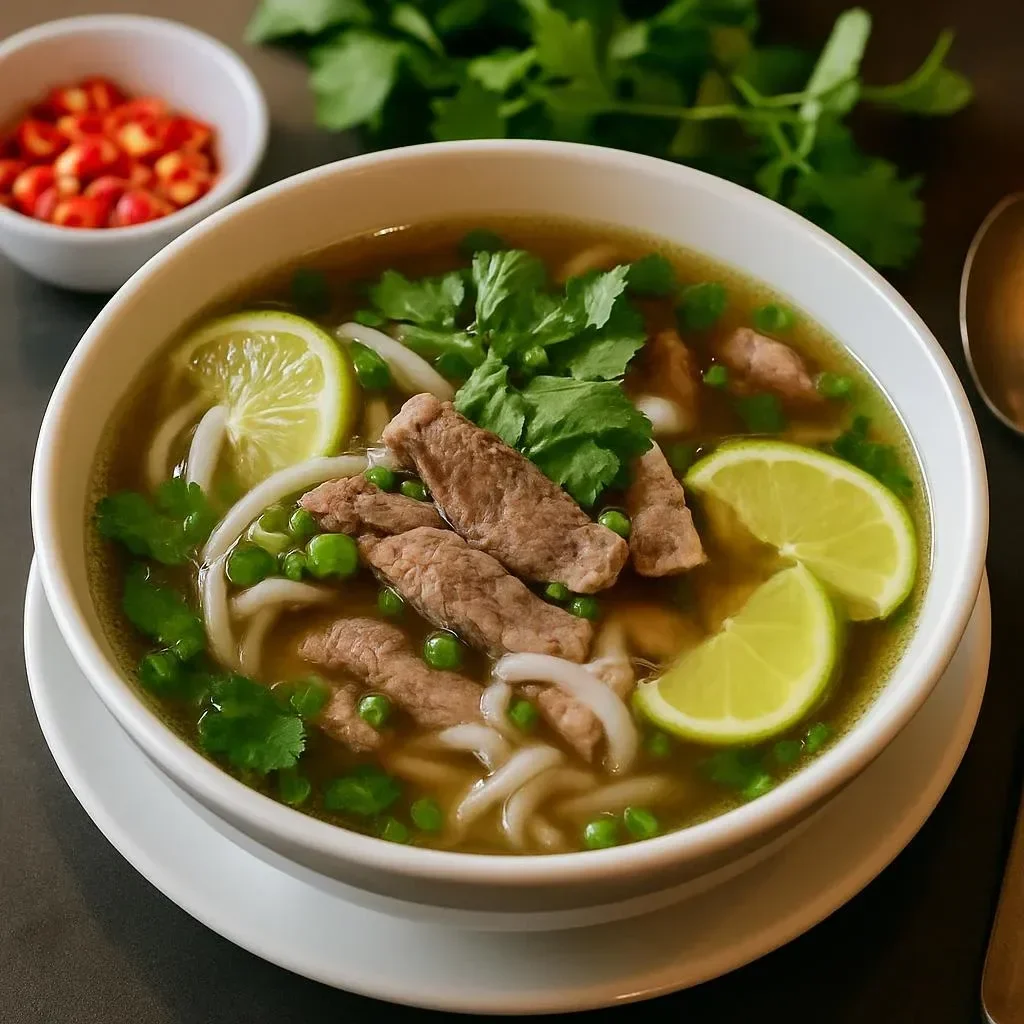Pho: Vietnamese Noodle Soup
Pho is so much more than just a bowl of soup; it’s a warm hug on a chilly day, bursting with fresh flavors and vibrant aromas. Making homemade pho has become a cherished ritual in my kitchen, and I’ve spent countless hours perfecting this recipe. There’s something truly special about crafting a bowl of soup that reflects rich culinary traditions while still being accessible to everyday cooks.
Why Make This Recipe
- Flavor Explosion: Each bowl of pho offers a delightful balance of savory broth, aromatic herbs, and tender noodles, making it a feast for the senses.
- Nutritional Benefits: Packed with protein, fiber, and vitamins, pho is not just tasty but also a nutritious choice for lunch or dinner.
- Convenience: While it may seem complex, this recipe is straightforward and can be prepared in a few hours, perfect for meal prep or a cozy weekend dinner.
- Customizable: Pho can be adapted to suit various tastes and dietary preferences, making it a versatile option for everyone.
- Cultural Connection: Making pho at home allows you to connect with Vietnamese culture and culinary heritage, bringing a slice of Vietnam to your table.
My heart warms every time I make pho because it reminds me of my travels through Vietnam, where I first tasted the magical broth at a tiny roadside vendor.
Recipe Overview
- Prep Time: 30 minutes
- Cook Time: 2 hours
- Total Time: 2 hours 30 minutes
- Servings: 4
- Difficulty Level: Easy
- Cooking Method: Simmering & Straining
This pho recipe involves simmering bones and spices to create a rich and flavorful broth, followed by assembling the soup with fresh herbs, rice noodles, and meat.
My Experience Making This Recipe
When I first attempted to make pho, I underestimated the importance of good broth. After a few tries, I learned that simmering the bones is crucial for extracting those deep flavors. I also discovered that balancing the spices is an art form; it took several iterations to get it just right.
How to Make Pho
The process of making pho involves crafting a fragrant broth, which serves as the base of your dish. Begin by simmering beef bones, onions, ginger, and spices for a couple of hours to extract maximum flavor. While the broth simmers, you can prepare the rice noodles and fresh garnishes. Once everything is ready, strain the broth, combine it with the noodles and desired proteins, and serve with an array of herbs.
Expert Tips for Success
- Choose Quality Bones: The best broth comes from roasting beef bones beforehand to enhance their flavor. Look for a mix of marrow and knuckle bones.
- Spices Matter: Use whole spices like star anise, cloves, and coriander for better flavor. Toast them lightly before adding to the broth to unlock their essential oils.
- Skim the Broth: Regularly skim off any foam or impurities during simmering. This helps achieve a clear, refined broth.
- Fresh Ingredients: Use fresh herbs such as cilantro, basil, and mint for garnish. They’re essential for that authentic pho flavor.
- Don’t Rush the Broth: Patience is key. The longer you simmer the broth, the richer the flavor will be.
How to Serve Pho
Serve your pho steaming hot in large bowls, garnishing with plenty of fresh herbs and sliced chilies. A side of lime wedges adds a zesty touch, while hoisin and sriracha sauces elevate the flavor even more. It’s perfect for cozy dinners or casual gatherings, where everyone can customize their bowls to their liking.
Storage and Reheating Guide
Store leftover pho broth and noodles separately in airtight containers. The broth can last in the refrigerator for up to 5 days or be frozen for up to 3 months. Noodles should be consumed within a day or two to maintain their texture. When reheating, gently warm the broth on the stove and add fresh noodles to keep them from becoming mushy.
Recipe Variations
- Vegetarian Pho: Swap the beef bones for vegetable broth and add mushrooms for depth.
- Gluten-Free: Use gluten-free rice noodles and ensure your sauces are gluten-free.
- Spicy Pho: Add more fresh chilies or a dash of chili oil for a kick.
- Herb-Heavy: Experiment with different herbs, such as Thai basil, for unique flavor profiles.
Nutritional Highlights
Pho is a good source of protein, thanks to the meat or tofu added. It’s also rich in vitamins from the fresh herbs and lime. If you’re careful with portions, it can be a healthy option. Note that the traditional recipe may not be suitable for those with gluten allergies unless modified.
Troubleshooting Common Issues
- Cloudy Broth: This typically occurs from impurities not being skimmed off. Make sure to regularly remove foam during simmering.
- Weak Flavor: If your broth tastes flat, consider simmering longer or adding more spices until you achieve the desired depth.
- Overcooked Noodles: Add the noodles just before serving and ensure to monitor cooking times closely.
Frequently Asked Questions
-
Can I use chicken instead of beef?
Yes! Chicken pho is a popular variation. Just adjust your simmering time and flavors accordingly. -
What type of noodles are best for pho?
Flat rice noodles, often labeled as "banh pho," work best for pho. Stick to the medium or large size for that authentic experience. -
Can I make pho in a slow cooker?
Absolutely! Use the slow cooker to simmer your broth for 8-10 hours for deep flavor. Just be sure to strain the broth before serving. -
What can I substitute for beef in pho?
Tofu, seitan, or a variety of vegetables can be used to replace beef, especially in vegetarian versions.

Pho: Vietnamese Noodle Soup
- Total Time: 150
- Yield: 4 servings
- Diet: Gluten-Free, Dairy-Free, Protein-rich
Description
A flavorful Vietnamese noodle soup with tender meat, fresh herbs, and a rich aromatic broth.
Ingredients
- 2 lbs beef bones (marrow and knuckle)
- 1 onion, halved
- 1 piece of ginger, halved
- 5 star anise
- 4 cloves
- 1 tsp coriander seeds
- 1 lb flat rice noodles (banh pho)
- Fresh herbs (cilantro, basil, mint)
- Chilies, sliced
- Lime wedges
- Hoisin sauce
- Sriracha sauce
Instructions
- Roast beef bones in the oven to enhance flavor.
- Simmer bones, onion, ginger, and spices in water for 2 hours.
- Strain the broth to remove solids.
- Prepare rice noodles according to package instructions.
- In bowls, add noodles, proteins, and pour the hot broth over.
- Garnish with fresh herbs, chilies, and serve with lime and sauces.
Notes
Be patient with the broth; the longer you simmer, the richer the flavor. Use high-quality ingredients for best results.
- Prep Time: 30
- Cook Time: 120
- Category: Main Course
- Method: Simmering & Straining
- Cuisine: Vietnamese

